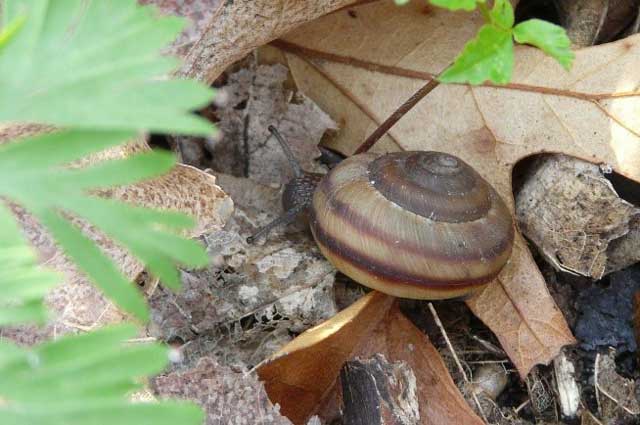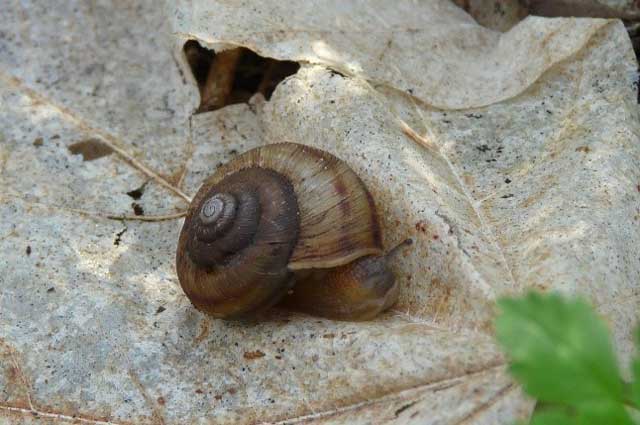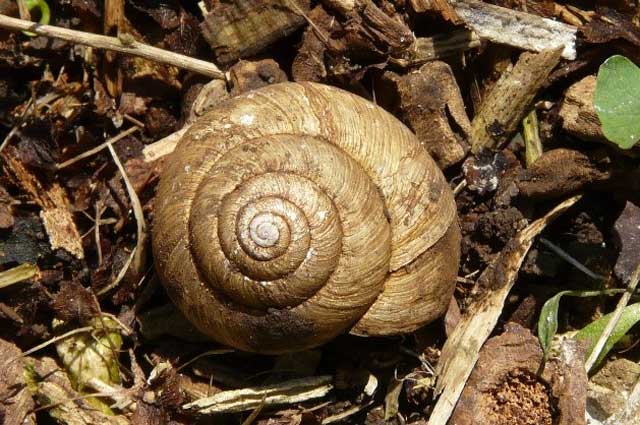Eastern banded tigersnail
Scientific name: Anguispira kochi kochi



Photo credit: Annegret Nicolai
Status
Endangered
“Endangered” means the species lives in the wild in Ontario, but is facing imminent extinction or extirpation.
Date added to the Species at Risk in Ontario List
August 1, 2018
What it looks like
The Eastern Banded Tigersnail is a large terrestrial snail that ranges from 2.0 to 2.5 centimetres in size. It has a circular shell that is yellow to brown with a distinct light-coloured spiral band that is bordered by a darker band on either side. In Ontario, there is variation in the size, morphology and colour of the shells.
Where it lives
In Canada, the Eastern Banded Tigersnail inhabits moist old hardwood or mixed-wood forests. In Ontario, it has been found in Chinquapin Oak-Nodding Onion treed alvar, dry-fresh Hackberry deciduous forest, dry-fresh Sugar Maple-White Ash deciduous forest, and dry Black Oak woodland. These habitats are described as having either limestone bedrock with vegetative cover or sandy soil with a leaf litter layer.
Where it’s been found in Ontario
The Eastern Banded Tigersnail currently occurs on two islands in Lake Erie: Pelee Island and Middle Island. It was also historically found on Middle Sister Island, East Sister Island and North Harbour Island but now appears to be extirpated from these locations. It is unknown if this species still exists on Hen Island.
What threatens it
The greatest threat to the Eastern Banded Tigersnail on Pelee and Middle Islands is climate change that has increased the incidence of droughts, severe storms with flooding and temperature extremes. Other threats include trampling, competition with invasive terrestrial snails and slugs, predation from birds, and the alteration of habitat by Double-crested Cormorants.
Actions we are taking
Endangered species and their general habitat are automatically protected.
Recovery strategy
A recovery strategy advises the ministry on ways to ensure healthy numbers of the species return to Ontario.
Read the executive summary and the full document (July 22, 2019)
Government response statement
A government response statement outlines the actions the government intends to take or support to help recover the species.
Read the government response statement (April 23, 2020)
What you can do
Report a sighting
- Report a sighting of an endangered animal or plant to the Natural Heritage Information Centre. Photographs with specific locations or mapping coordinates are always helpful.
Volunteer
- Volunteer with your local nature club or provincial park to participate in surveys or stewardship work focused on species at risk.
Be a good steward
- Private land owners have a very important role to play in species recovery. If you find Eastern Banded Tigersnail on your land, you may be eligible for stewardship programs that support the protection and recovery of species at risk and their habitats.
Report illegal activity
- Report any illegal activity related to plants and wildlife to
1-877-TIP-SMNR (847-7667)
Quick facts
- The Eastern Banded Tigersnail plays an important role in litter decomposition, nutrient cycling and soil building processes.
- In the winter, individual snails seek moist refuge including snow cover to survive freezing temperatures.
- Weathered shells of the Eastern Banded Tigersnail indicate that it has a long lifespan of 5 to 10 years.